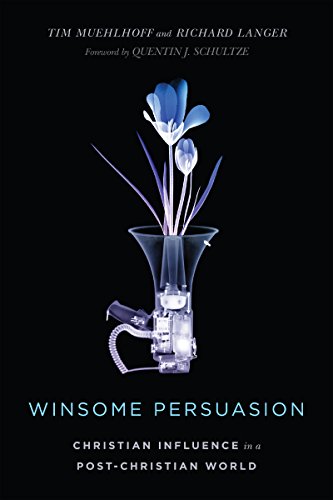
Author Bios
Winsome Persuasion was written in tandem by Tim Muehlhoff and Richard Langer. Tim Muehlhoff is currently Professor of Communication Studies at Biola University teaching classes on family communication, interpersonal communication, apologetics, gender, and conflict resolution and works for their Center for Marriage and Relationships where he is an author, speaker, and a co-host of a podcast called The Art of Relationships. He formerly worked for over thirty years with the campus ministry Cru (formerly known as Campus Crusade for Christ).[1] He holds a Ph.D. in communication theory from the University of North Carolina at Chapel Hill (where he also taught for a time). His research interests include social justice, gender, family communication, interpersonal communication and persuasion.[2]
Richard Langer is currently Professor of Biblical and Theological studies at Biola University’s Talbot School of Theology and serves as the Director of the Office for the Integration of Faith and Learning, also at Biola University. Before that, he served for over twenty years as pastor at Trinity Evangelical Free Church in Redlands, California. He holds a Ph.D. from the University of California, Riverside. His specialization is in the area of integrating faith and learning, and he has published in the areas of bioethics, theology, and philosophy.[3]
Summary & Major Elements
As the subtitle of the book, Christian Influence in a Post-Christian World, suggests, the purpose of the book is to examine how Christians can still have influence in the world that we find ourselves in, one that seems so opposed to all we believe. The authors focus on what this looks like in a public setting, not so much on what it is like in private relationships. The reason for this seems to be that Christians today seem at a loss as to how to have an effective voice in the public ear. They seek to provide tools for having constructive public conversations.
The first part of the book lays down a theoretical foundation for what it looks like for a counterpublic to communicate effectively in today’s public square. A public is defined as a group that has a voice in society. Whether this voice is actually heard is irrelevant to the theoretical foundation. The public can be weak (having little influence) or strong (having great influence). The weak and strong publics can also be defined as being a minority view or majority view on an issue, respectively. A counterpublic is created when a weak, unheard (or little heard) public seeks to make changes in society. Obviously, the way those changes are invoked are through first engaging with the strong public (those with influence or power to make changes happen) and persuading them to change their views. This is no easy task, and it becomes harder when Christians attempt this feat and attempt it with gentleness and respect as we are called to do. An effective Christian counterpublic, in order to have any effect, must move through the noise of our argument culture by being compassionate and empathetic and by building our credibility by living lives that reflect the truth and benefit of the values we seek to advocate for.
The second part of the book deals with how to take the theoretical foundation and apply it to engaging others with our message. The authors first deal with crafting a message. We want to be able to craft a message that others will consider it not only cognitively but also emotionally, speaking to the public in a way that shows them that they should love what we love and hate what we hate. Once the message is crafted and tested, we then must deliver our message in a way that is compelling using statistics and stories that capture the hearts and minds of the hearers. Finally, we should always be on the lookout for unlikely partnerships with non-Christians groups that may help us to create a wider and stronger influence, even if those groups are opposed to other beliefs we have.
The last part of the book gives an apt example for our time and age as each of the authors separately took on the issue of how to effectively respond to the Obergefell decision on same-sex marriage. Each author took a different stance on what would be most effective, but both sought to show how all of the previous content of the book could like practically.
Author’s Aim/Purpose
You could almost derive the purpose of this book from its title and subtitle. The title, Winsome Persuasion, alone implies that the aim is to teach the reader how to persuade others in a winsome (i.e., attractive or appealing) way. This means that the aim is not to show how to persuade with force or at all costs. To be winsome is to win people over or make others see you (or your message) as desirable. Then in the subtitle, Christian Influence in a Post-Christian World, we see those that must learn to winsomely persuade are Christians and that the reason for this necessity is the reality of the world they live in, a post-Christian world.
When reading through the book, another major aim becomes clear: that Christians must learn to bring influence in society through the public square to a public that opposes, sometimes vehemently opposes, the values and causes they hold dear. The distinctive here is that they are not aiming to teach the reader how to have an effective private conversation with a non-Christian. I do not think the authors aim to say that effective private communication is unnecessary or futile, of course. They simply think that the time and place we find ourselves in calls for something more drastic and big-picture in addition to private persuasiveness.
I found that an overall aim of the book that is shown throughout is to recover the art of civil discourse and to do so by being a neighbor instead of worrying so much about who our neighbor is. This is an allusion to the time when Jesus was asked by an expert of the law, “And who is my neighbor?” Jesus proceeds to tell the Parable of the Good Samaritan and then flips the question on him asking, “Who in this story proved himself to be a neighbor?” The point here is that Jesus was more concerned with the man acting neighborly no matter who he was dealing with. Likewise, as we seek to gain influence as Christians in the world today, we must be civil and persuasive to everyone as we seek effective communication.
Evaluation
The question at hand is whether Muehlhoff and Langer winsomely persuaded me of the principles they presented in this book? I think I can unabashedly answer that question with a, “Yes!” I found the theoretical foundation they laid helpful to seeing both why it is that public discourse is in the trouble it is and how to begin moving forward against the stream of ineffective, and sometimes toxic, communication in the public square. I do think that there could have been more discussion on social media as a public square and how to use it effectively. I found the sections that addressed this issue to be lacking. The content on social media that was in the book was helpful, but I thought that there could have been a more thorough examination. Perhaps the authors thought that it would be best to let the reader figure out how to take the overall principles and apply them to whatever platform they decide to use?
One of my favorite things about the book are the historical sketches found throughout. After each major principle is explained, there is a short historical sketch examining how we can see that principle as it has actually played out in real life. This was very helpful because sometimes books like this tend to send you down the runway with a successful takeoff but leave you up in the air with a lot of great ideas and no vision of how to actually land the plane. The historical sketches keep the philosophy grounded by showing you real life examples of how the principles work. For example, the last historical sketch shows what it might look like to form loose connections with unlikely partners for our cause through the life of William Wilberforce and his lifelong messy connection with the British Parliament. I wish more books effectively did what Muehlhoff and Langer did with the historical sketches in this book.
Finally, I appreciated that the authors also sought to give you a launching point on how to begin thinking about an issue that is relevant and pressing for Christians now. Their final chapters expressing and then discussing their differing opinions on how to effectively respond to the Obergefell decision were very helpful. If the reader is looking for a definitive answer, he or she will be disappointed, but I do not think that was the aim. I think the authors simply wanted to give us a springboard, a starting point, on what it looks like to begin crafting a message to deal with a pressing and real issue.
Overall, I gave this book a five out of five. I would highly recommend it to all Christians leaders today. It addresses a vital need in the Church, and it does so with courage and urgency.
[1] “Timothy Muehlhoff,” Biola University, https://www.biola.edu/directory/people/timothy-muehlhoff (accessed March 26, 2018).
[2] “Bio,” Tim Muehlhoff, http://www.timmuehlhoff.com/bio-3/ (accessed March 26, 2018).
[3] “Richard C. Langer,” Biola University, https://www.biola.edu/directory/people/richard-langer (accessed March 26, 2018).





